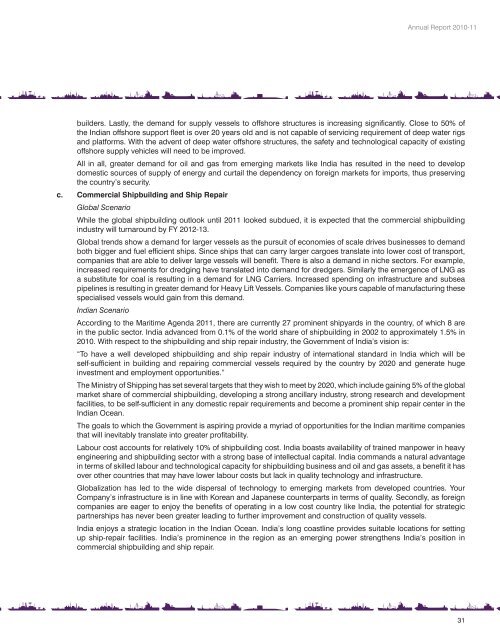Annual Report FY 2010-11 - Pipavav Shipyard
Annual Report FY 2010-11 - Pipavav Shipyard
Annual Report FY 2010-11 - Pipavav Shipyard
Create successful ePaper yourself
Turn your PDF publications into a flip-book with our unique Google optimized e-Paper software.
<strong>Annual</strong> <strong>Report</strong> <strong>2010</strong>-<strong>11</strong><br />
�������������<br />
builders. Lastly, the demand for supply vessels to offshore structures is increasing significantly. Close to 50% of<br />
the Indian offshore support fleet is over 20 years old and is not capable of servicing requirement of deep water rigs<br />
and platforms. With the advent of deep water offshore structures, the safety and technological capacity of existing<br />
offshore supply vehicles will need to be improved.<br />
All in all, greater demand for oil and gas from emerging markets like India has resulted in the need to develop<br />
domestic sources of supply of energy and curtail the dependency on foreign markets for imports, thus preserving<br />
the country’s security.<br />
c. Commercial Shipbuilding and Ship Repair<br />
Global Scenario<br />
While the global shipbuilding outlook until 20<strong>11</strong> looked subdued, it is expected that the commercial shipbuilding<br />
industry will turnaround by <strong>FY</strong> 2012-13.<br />
Global trends show a demand for larger vessels as the pursuit of economies of scale drives businesses to demand<br />
both bigger and fuel efficient ships. Since ships that can carry larger cargoes translate into lower cost of transport,<br />
companies that are able to deliver large vessels will benefit. There is also a demand in niche sectors. For example,<br />
increased requirements for dredging have translated into demand for dredgers. Similarly the emergence of LNG as<br />
a substitute for coal is resulting in a demand for LNG Carriers. Increased spending on infrastructure and subsea<br />
pipelines is resulting in greater demand for Heavy Lift Vessels. Companies like yours capable of manufacturing these<br />
specialised vessels would gain from this demand.<br />
Indian Scenario<br />
According to the Maritime Agenda 20<strong>11</strong>, there are currently 27 prominent shipyards in the country, of which 8 are<br />
in the public sector. India advanced from 0.1% of the world share of shipbuilding in 2002 to approximately 1.5% in<br />
<strong>2010</strong>. With respect to the shipbuilding and ship repair industry, the Government of India’s vision is:<br />
“To have a well developed shipbuilding and ship repair industry of international standard in India which will be<br />
self-sufficient in building and repairing commercial vessels required by the country by 2020 and generate huge<br />
investment and employment opportunities.”<br />
The Ministry of Shipping has set several targets that they wish to meet by 2020, which include gaining 5% of the global<br />
market share of commercial shipbuilding, developing a strong ancillary industry, strong research and development<br />
facilities, to be self-sufficient in any domestic repair requirements and become a prominent ship repair center in the<br />
Indian Ocean.<br />
The goals to which the Government is aspiring provide a myriad of opportunities for the Indian maritime companies<br />
that will inevitably translate into greater profitability.<br />
Labour cost accounts for relatively 10% of shipbuilding cost. India boasts availability of trained manpower in heavy<br />
engineering and shipbuilding sector with a strong base of intellectual capital. India commands a natural advantage<br />
in terms of skilled labour and technological capacity for shipbuilding business and oil and gas assets, a benefit it has<br />
over other countries that may have lower labour costs but lack in quality technology and infrastructure.<br />
Globalization has led to the wide dispersal of technology to emerging markets from developed countries. Your<br />
Company’s infrastructure is in line with Korean and Japanese counterparts in terms of quality. Secondly, as foreign<br />
companies are eager to enjoy the benefits of operating in a low cost country like India, the potential for strategic<br />
partnerships has never been greater leading to further improvement and construction of quality vessels.<br />
India enjoys a strategic location in the Indian Ocean. India’s long coastline provides suitable locations for setting<br />
up ship-repair facilities. India’s prominence in the region as an emerging power strengthens India’s position in<br />
commercial shipbuilding and ship repair.<br />
�������������<br />
31


